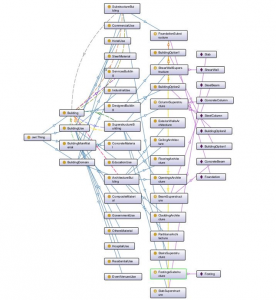1. Introduction
Designing, construction, and even maintenance of building projects often require collaboration among various experts from different disciplines such as civil engineers, architects, mechanical engineers, as well as multiple stakeholders and contractors. The current ontology can facilitate the integration between mentioned people by providing a common language and framework for these diverse fields, ensuring seamless communication and collaboration. Furthermore, this can be used as a reliable reference in future probable modification, maintenance interventions as well as designing similar projects.
2. Purpose
The purpose of this ontology is to provide a guideline for the designers as well as the stakeholders of multi-story buildings. Using this ontology they can decide on the best suitable system, sub-system and elements on their projects. Additionally, this ontology can be used as a reference for projects like rehabilitation, expansion, and maintenance interventions. This ontology also can be used as a source for research in the multi-story domain.
3. Scope
This ontology mainly focuses on the structural integrity of the multi-story buildings. Because of the fact that a building is constituted of several sub-systems and hundreds of elements and considering all of them into consideration is far beyond the scope of this assignment. However, for providing a comprehensive overview and also to facilitate future expansion of this ontology, other interconnected and influential subsystems such as architectural subsystems and utility services are added into the overall view of the ontology.
4. Intended users
The intended users encompass engineers and designers involved in the design of multi-story buildings for diverse purposes such as residential, commercial, offices, education, and more. Additionally, stakeholders and engineers can leverage this ontology for rehabilitation and expansion projects within existing buildings. Concurrently, university researchers can utilize this ontology to gain a comprehensive understanding of various building subsystems and components. Finally, software developers seeking to create tools for structural analysis and design can derive significant value by using this ontology as a reference or foundation for their applications.
5. Intended use
This ontology provides valuable guidelines and constraints during the design phase, leading to more informed insights. Additionally, it could be a valuable tool in strategic decision-making, particularly in material selection and construction methodologies. Moreover, it can be used as a foundational platform for developing computer models, enhancing structural analysis, and predictive simulations.

Downloadable Content
Full Report: Eisa Sabahi